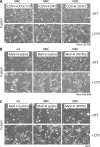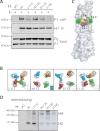Structural rearrangements of the central region of the morbillivirus attachment protein stalk domain trigger F protein refolding for membrane fusion
- PMID: 22431728
- PMCID: PMC3351323
- DOI: 10.1074/jbc.M112.342493
Structural rearrangements of the central region of the morbillivirus attachment protein stalk domain trigger F protein refolding for membrane fusion
Abstract
It is unknown how receptor binding by the paramyxovirus attachment proteins (HN, H, or G) triggers the fusion (F) protein to fuse with the plasma membrane for cell entry. H-proteins of the morbillivirus genus consist of a stalk ectodomain supporting a cuboidal head; physiological oligomers consist of non-covalent dimer-of-dimers. We report here the successful engineering of intermolecular disulfide bonds within the central region (residues 91-115) of the morbillivirus H-stalk; a sub-domain that also encompasses the putative F-contacting section (residues 111-118). Remarkably, several intersubunit crosslinks abrogated membrane fusion, but bioactivity was restored under reducing conditions. This phenotype extended equally to H proteins derived from virulent and attenuated morbillivirus strains and was independent of the nature of the contacted receptor. Our data reveal that the morbillivirus H-stalk domain is composed of four tightly-packed subunits. Upon receptor binding, these subunits structurally rearrange, possibly inducing conformational changes within the central region of the stalk, which, in turn, promote fusion. Given that the fundamental architecture appears conserved among paramyxovirus attachment protein stalk domains, we predict that these motions may act as a universal paramyxovirus F-triggering mechanism.
Figures






References
-
- Chen S. Y., Anderson S., Kutty P. K., Lugo F., McDonald M., Rota P. A., Ortega-Sanchez I. R., Komatsu K., Armstrong G. L., Sunenshine R., Seward J. F. (2011) Health care-associated measles outbreak in the United States after an importation: challenges and economic impact. J. Infect. Dis. 203, 1517–1525 - PubMed
-
- Tatsuo H., Ono N., Tanaka K., Yanagi Y. (2000) SLAM (CDw150) is a cellular receptor for measles virus. Nature 406, 893–897 - PubMed
-
- Dörig R. E., Marcil A., Chopra A., Richardson C. D. (1993) The human CD46 molecule is a receptor for measles virus (Edmonston strain). Cell 75, 295–305 - PubMed
-
- Negrete O. A., Levroney E. L., Aguilar H. C., Bertolotti-Ciarlet A., Nazarian R., Tajyar S., Lee B. (2005) EphrinB2 is the entry receptor for Nipah virus, an emergent deadly paramyxovirus. Nature 436, 401–405 - PubMed
Publication types
MeSH terms
Substances
Grants and funding
LinkOut - more resources
Full Text Sources

